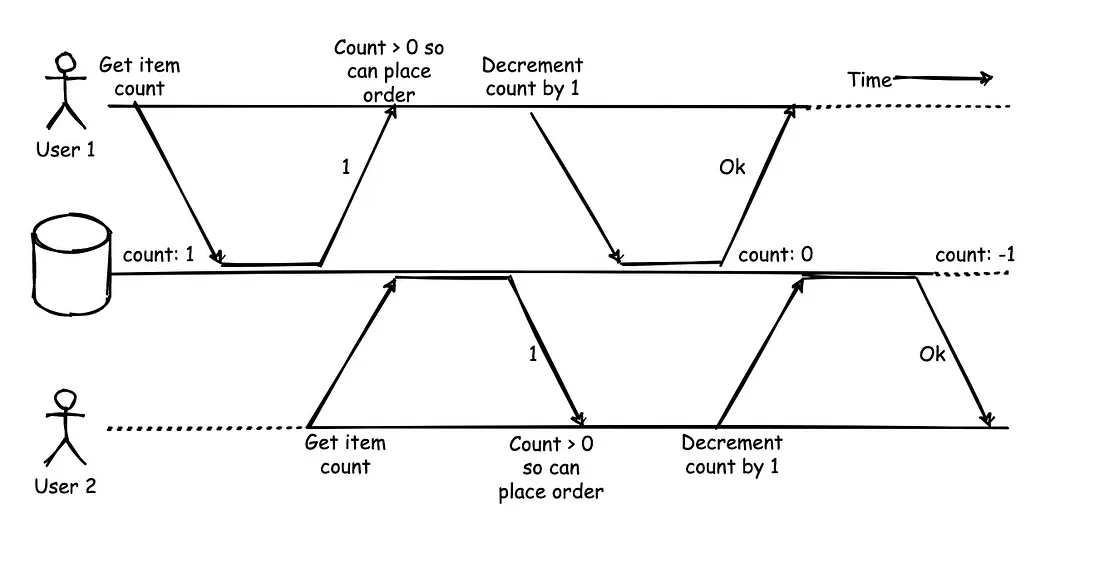Race Condition과 해결 전략
Race Condition이란?
Race Condition(경쟁 상태)은 멀티스레드 환경에서 두 개 이상의 스레드가 공유 자원에 동시에 접근할 때, 실행 순서에 따라 결과가 달라지는 상황을 말합니다. 이는 프로그램의 예측 불가능성과 버그를 야기하는 주요 원인 중 하나입니다.
Race Condition 발생 조건
Race Condition이 발생하기 위해서는 다음 세 가지 조건이 모두 만족되어야 합니다:
- Mutual Exclusion (상호 배제): 공유 자원이 존재
- Hold and Wait (점유 대기): 스레드가 자원을 점유한 상태에서 다른 자원을 기다림
- No Preemption (선점 불가): 다른 스레드가 강제로 자원을 빼앗을 수 없음
Race Condition 시퀀스 다이어그램
다음은 재고 관리 시스템에서 발생하는 전형적인 Race Condition을 보여주는 시퀀스 다이어그램입니다
출처: Phantom Reads & Race Condition on Database
다이어그램 설명
이 다이어그램은 두 사용자가 동시에 재고 1개인 상품을 구매하려고 할 때 발생하는 Race Condition을 보여줍니다:
- 초기 상태: 데이터베이스에 재고 1개 (
count: 1) - User 1: 재고 확인 → 1개 확인 → 주문 가능 판단 → 재고 감소 요청
- User 2: 동시에 재고 확인 → 1개 확인 → 주문 가능 판단 → 재고 감소 요청
- 결과: 두 사용자 모두 주문 성공했지만, 재고는 -1이 됨
이는 Read-Modify-Write 패턴이 원자적이지 않아서 발생하는 전형적인 Race Condition입니다.
이 문제의 해결 방법
1. 데이터베이스 락 사용
SQL 예시:
1
2
3
4
5
6
7
8
9
10
-- 비관적 락 (Pessimistic Lock)
SELECT count FROM inventory WHERE item_id = ? FOR UPDATE;
UPDATE inventory SET count = count - 1 WHERE item_id = ?;
-- 원자적 연산
UPDATE inventory SET count = count - 1 WHERE item_id = ? AND count > 0;
-- 낙관적 락 (Optimistic Lock)
UPDATE inventory SET count = count - 1, version = version + 1
WHERE item_id = ? AND version = ? AND count > 0;
Spring Boot 예시:
1
2
3
4
5
6
7
8
9
10
11
12
13
14
15
16
17
18
19
20
21
22
23
24
25
26
27
28
29
30
31
32
33
34
35
36
37
@Service
@Transactional
public class InventoryService {
@Autowired
private InventoryRepository inventoryRepository;
// 비관적 락 사용
public boolean purchaseWithPessimisticLock(Long itemId, int quantity) {
Inventory inventory = inventoryRepository.findByIdWithLock(itemId);
if (inventory.getCount() >= quantity) {
inventory.setCount(inventory.getCount() - quantity);
inventoryRepository.save(inventory);
return true;
}
return false;
}
// 원자적 연산 사용
public boolean purchaseWithAtomicOperation(Long itemId, int quantity) {
int updatedRows = inventoryRepository.decreaseCountIfAvailable(itemId, quantity);
return updatedRows > 0;
}
// 낙관적 락 사용
public boolean purchaseWithOptimisticLock(Long itemId, int quantity, int version) {
try {
int updatedRows = inventoryRepository.decreaseCountWithVersion(
itemId, quantity, version);
return updatedRows > 0;
} catch (OptimisticLockingFailureException e) {
// 버전 충돌 발생 시 재시도 로직
return retryPurchase(itemId, quantity);
}
}
}
1
2
3
4
5
6
7
8
9
10
11
12
13
14
15
16
17
18
19
20
21
22
23
@Repository
public interface InventoryRepository extends JpaRepository<Inventory, Long> {
// 비관적 락을 위한 쿼리
@Lock(LockModeType.PESSIMISTIC_WRITE)
@Query("SELECT i FROM Inventory i WHERE i.id = :itemId")
Inventory findByIdWithLock(@Param("itemId") Long itemId);
// 원자적 연산을 위한 쿼리
@Modifying
@Query("UPDATE Inventory i SET i.count = i.count - :quantity " +
"WHERE i.id = :itemId AND i.count >= :quantity")
int decreaseCountIfAvailable(@Param("itemId") Long itemId,
@Param("quantity") int quantity);
// 낙관적 락을 위한 쿼리
@Modifying
@Query("UPDATE Inventory i SET i.count = i.count - :quantity, i.version = i.version + 1 " +
"WHERE i.id = :itemId AND i.version = :version AND i.count >= :quantity")
int decreaseCountWithVersion(@Param("itemId") Long itemId,
@Param("quantity") int quantity,
@Param("version") int version);
}
비관적 락 (Pessimistic Lock)은 데이터베이스 레벨에서 행을 잠그는 방식입니다. FOR UPDATE 절을 사용하여 특정 행에 대한 배타적 락을 획득하고, 다른 트랜잭션이 해당 행을 수정할 수 없도록 합니다. 이 방법은 데이터 일관성을 보장하지만, 락을 기다리는 동안 성능 저하가 발생할 수 있습니다.
원자적 연산은 단일 SQL 문으로 읽기와 쓰기를 동시에 수행하는 방식입니다. UPDATE 문의 WHERE 절에서 조건을 확인하고 동시에 값을 변경하므로, Race Condition을 방지할 수 있습니다. 이 방법은 성능이 우수하고 구현이 간단하지만, 복잡한 비즈니스 로직에는 적용하기 어렵습니다.
낙관적 락 (Optimistic Lock)은 버전 필드를 사용하여 데이터 변경을 추적하는 방식입니다. 트랜잭션이 시작될 때 버전을 읽고, 업데이트 시 버전이 변경되지 않았는지 확인합니다. 버전이 다르면 다른 트랜잭션이 데이터를 수정한 것이므로 재시도 로직을 수행합니다. 이 방법은 성능이 우수하지만 구현이 복잡하고 재시도 로직이 필요합니다.
2. Spring의 @Transactional과 격리 수준 설정
1
2
3
4
5
6
7
8
9
10
11
12
13
14
15
16
17
18
19
20
21
22
23
24
25
26
27
28
29
30
31
32
33
34
@Service
public class TransactionalInventoryService {
@Autowired
private InventoryRepository inventoryRepository;
// SERIALIZABLE 격리 수준으로 Race Condition 방지
@Transactional(isolation = Isolation.SERIALIZABLE)
public boolean purchaseWithSerializable(Long itemId, int quantity) {
Inventory inventory = inventoryRepository.findById(itemId)
.orElseThrow(() -> new RuntimeException("상품을 찾을 수 없습니다."));
if (inventory.getCount() >= quantity) {
inventory.setCount(inventory.getCount() - quantity);
inventoryRepository.save(inventory);
return true;
}
return false;
}
// REPEATABLE_READ 격리 수준으로 Phantom Read 방지
@Transactional(isolation = Isolation.REPEATABLE_READ)
public boolean purchaseWithRepeatableRead(Long itemId, int quantity) {
Inventory inventory = inventoryRepository.findById(itemId)
.orElseThrow(() -> new RuntimeException("상품을 찾을 수 없습니다."));
if (inventory.getCount() >= quantity) {
inventory.setCount(inventory.getCount() - quantity);
inventoryRepository.save(inventory);
return true;
}
return false;
}
}
SERIALIZABLE 격리 수준은 가장 엄격한 격리 수준으로, 트랜잭션들이 순차적으로 실행되는 것처럼 동작합니다. 이는 모든 Race Condition을 방지할 수 있지만, 성능 저하가 심각할 수 있습니다. 특히 동시성이 높은 환경에서는 사용을 피하는 것이 좋습니다.
REPEATABLE_READ 격리 수준은 트랜잭션 내에서 동일한 쿼리를 여러 번 실행해도 같은 결과를 보장합니다. Phantom Read는 방지하지만, 일부 Race Condition은 여전히 발생할 수 있습니다. 대부분의 경우에 적절한 성능과 일관성의 균형을 제공합니다.
해결 방법별 장단점
| 방법 | 장점 | 단점 | 사용 시기 |
|---|---|---|---|
| 비관적 락 | 데이터 일관성 보장, 구현 간단 | 성능 저하, 데드락 위험 | 높은 일관성이 필요한 경우 |
| 낙관적 락 | 성능 우수, 데드락 없음 | 구현 복잡, 재시도 로직 필요 | 충돌이 적은 경우 |
| 원자적 연산 | 성능 우수, 구현 간단 | 복잡한 로직 처리 어려움 | 단순한 증감 연산 |
| 격리 수준 조정 | 데이터베이스 레벨 보장 | 성능 영향, 복잡한 설정 | 데이터베이스 중심 해결 |
이러한 방법들을 상황에 맞게 선택하여 Race Condition을 효과적으로 방지할 수 있습니다.
